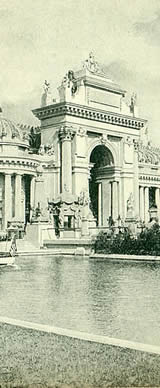An Introduction
The Louisiana Purchase Exposition of 1904 was by all accounts the most beautiful, educational and exciting of all the international exhibitions of global culture ever presented. The world was at peace and technology promised a future beyond all imagination. 62 nations and 43 states brought their treasures and their civilizations to St. Louis to display and demonstrate humanity's advancements since the Louisiana Purchase.

Built on over 1,200 acres in the heart of St. Louis, it was the largest fair ever held. With its immense architecture, broad boulevards, curved bridges and landscaped water vistas, the beauty of the Fair was unmatched! For 7 months in the summer of 1904, the city of St. Louis became the “World’s University.” The Fair offered its students an opportunity to learn first hand about the wonders and the cultures far removed from their everyday lives.
Cities at the turn of the century were expanding quickly, but not always in a structured, logical manner. The Fair was designed to demonstrate a model urban community of the future. The layout of this miniature city was carefully planned into different zones, each with a specific purpose. The Fair had limitless educational opportunities, little to no crime and an almost constant state of celebration. It truly became an ideal, utopian society.
The Fair planners celebrated a glorious past, acknowledged the accomplishments of the present and offered a glimpse into the possibilities of the future. The people of St. Louis put everything they had into celebrating the 100th anniversary of the Louisiana Purchase, and the result was the most spectacular World’s Fair ever created.
The Planning
A great deal of the Fair’s success is due to the extensive planning. The Exposition Company was created to coordinate the preparations, but the entire population of St. Louis worked toward the great event. Arrangements had to be made for such things as transportation, sanitation, fire protection and security. They needed hotels, restaurants, services and supplies for millions of additional people. The incredible physical effort of erecting the buildings, carving the lagoons and building the roads, sewers and power plants is to be marveled at in itself.
Originally the Fair was to open April 30, 1903, the 100th anniversary of the Louisiana Purchase treaty. However, as the scope of the Exposition broadened, it became clear that everything could not be completed by the scheduled date. Since the goal of the Exposition Company was to include everything possible, the officials decided to put off the opening date for one year. After three years of concentrated work, everything was finally finished.
The PalacesThe Exposition Company divided and displayed humanity's advancements into 12 major classifications, such as Transportation, Art, Anthropology and Education. These main exhibits were housed in the Palaces. These ornately detailed show-places, with their massive columns and spired towers, were immense and beautiful almost beyond description. Electric light, a recent innovation for the turn of the century, was used lavishly both for illumination and decoration.

The Palaces comprised 5 million square feet of exhibit space. The Agriculture Palace alone covered 23 acres. Just one of the medium sized Palaces required 95,000 sq. ft. of glass, 600 windows and doors, 450 tons of steel, and 7,000,000 feet of lumber. Since they were of temporary construction, their outsides were covered with 800,000 sq. ft. of staff, a mixture of plaster of paris and hemp fiber.
Education was the keynote of the Fair. The Exposition Company incorporated education into all aspects of the exhibits, and their presentation was both innovative and organized. Within the separate Palaces, the exhibits were arranged to show the process of how things were made, not just the items themselves. For example, one could watch the rope maker, the blacksmith or the farmer actually at work, and then see the results of his/her labor. There was even a model school, where the latest educational methods were demonstrated.
The Variety
It was impossible to see all of the fair in less than a week, or study it with any care in less than a month. There were over 1500 distinct buildings on 75 miles of walks and roadways. Each country, state and territory had its own building. There was a U. S. Government building, a bank, a hospital and a press building.
There were 7 churches, each one a replica of a famous place of worship. The official hotel on the Fairgrounds was the Inside Inn, which had 2257 rooms. Over 36,000 people could be served simultaneously throughout the Fair, and one large restaurant had seating for 4,800.
The 1904 Summer Olympic Games were held during the Fair. Francis Field, which had the first concrete stadium in the United States, was the most modern in the world at that period. With so many other events going on, the Olympics took on a minor role. The medals earned during the Fair have since become very desirable, and the Games themselves very interesting to research.
The Fair traveler may have chosen to visit the walled city of Jerusalem, a Japanese tea garden or a Chinese temple. There was a gigantic floral clock with hands 100 feet across, a sunken garden and the actual log cabin where Abraham Lincoln was born. One could travel over the lovely lagoons in a modern motor launch or in gaily decorated gondola. One could hire an automobile, a wheel chair, an Irish jaunting car or ride a camel, a turtle or an elephant.
There were almost daily celebrations, parades and special events. A designated committee made sure something was always going on. Some of the activities included president's week, flower show week and college week. There were weeks honoring specific states, and 32 different cities celebrated special days. There was even an official anti-cigarette day!
St. Louis, well known as a musical city, paid special attention to planning music of every variety. There were daily organ concerts in Festival Hall. The official Exposition Symphony Orchestra, under the direction of internationally famous conductors, performed popular concerts in the Tyrolean Alps. A choral group of nearly 3000 sang for special occasions. Every section of the fairgrounds featured outdoor concerts with music from a variety of internationally famous bands. John Philip Sousas’s celebrated group was a Fair favorite.
The Wonders on The Pike
The Pike was a mile long midway featuring rides, amusements and fantastic attractions. It was the headquarters for fun and adventure. The Pike was primarily a source of pleasure, but many of its features educated as they entertained. The old expression, “coming down the Pike” originated at the Fair, as you never knew what you would see next.

Visitors could scale the Tyrolean Alps, visit Blarney Castle or take in a Parisian fashion show. One could go deep sea diving, ride a burro to cliff dwellings or experience the “Hereafter.” An afternoon's activities might have included stalking wild animals, exploring the North Pole or walking the streets of ancient Rome. In the Naval Battle of Santiago, model ships staged war on a miniature lake. The food choices were just as diverse, and the Pike is the birthplace of the ice cream cone.
By day the Pike was an excited crowd of children, souvenir hunters, acrobats and clowns. By night it became a milling mob of pleasure seekers. 50 different shows could be seen in the Pike’s theaters. Here one could see the forms of entertainment popular in different parts of the world, and the people came out to play. Belly dancing fast became a favorite of many fairgoers.
The Memories
When the Exposition Company made the initial contracts to plan the Fair, they promised to restore the grounds to a public park. When it was all over, the tremendous buildings were salvaged and the wonderful fountains and cascades were demolished. Archaeologists are currently studying the immense landfills where the debris from the Fair was buried.
The times had been right for the coming together of people, but much of the credit should go to the people of St. Louis. They had indeed built a fair so comprehensive, so perfectly planned, that had some disaster wiped out every culture from the face of the Earth, all could have been reconstructed from the materials on hand.




